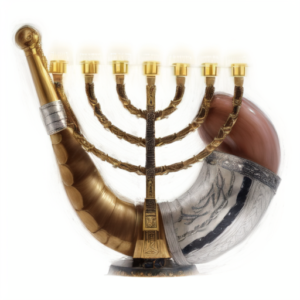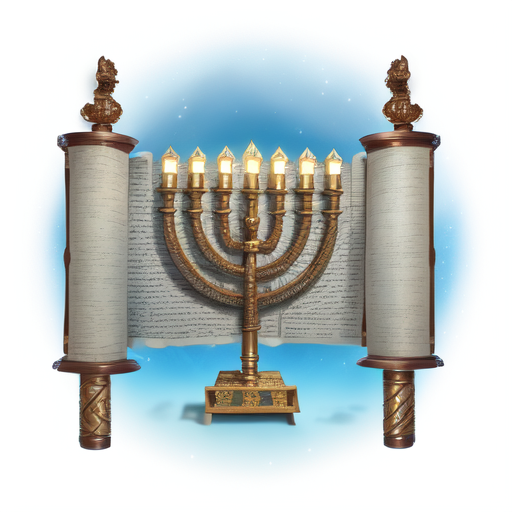Hebrews 9 (CJB)
9 1 Now the first covenant had both regulations for worship and a Holy Place here on earth. 2 A tent was set up, the outer one, which was called the Holy Place; in it were the menorah, the table and the Bread of the Presence. 3 Behind the second parokhet was a tent called the Holiest Place, 4 which had the golden altar for burning incense and the Ark of the Covenant, entirely covered with gold. In the Ark were the gold jar containing the man, Aharon’s rod that sprouted and the stone Tablets of the Covenant; 5 and above it were the k’ruvim representing the Sh’khinah, casting their shadow on the lid of the Ark—but now is not the time to discuss these things in detail.
David H. Stern, Complete Jewish Bible: An English Version of the Tanakh (Old Testament) and B’rit Hadashah (New Testament), 1st ed. (Clarksville, MD: Jewish New Testament Publications, 1998), Heb 9:1-10.
6 With things so arranged, the cohanim go into the outer tent all the time to discharge their duties; 7 but only the cohen hagadol enters the inner one; and he goes in only once a year, and he must always bring blood, which he offers both for himself and for the sins committed in ignorance by the people. 8 By this arrangement, the Ruach HaKodesh showed that so long as the first Tent had standing, the way into the Holiest Place was still closed. 9 This symbolizes the present age and indicates that the conscience of the person performing the service cannot be brought to the goal by the gifts and sacrifices he offers. 10 For they involve only food and drink and various ceremonial washings—regulations concerning the outward life, imposed until the time for God to reshape the whole structure.
What Do These Verses Teach?
Many Christian pastors and churches use this chapter, especially verses 9-10, to teach that the entire law is completely done away with and that it is no longer required. Well, I am here to show you that such teachings are inaccurate. After an in-depth look at these verses within the proper context, those reading this post will see that only the sacrificial and ceremonial systems for atonement have been done away with. Let us begin.
The Old Testament Ritual Described
We are now at the beginning of a lengthy section (9:1–10:18) that many believe is the heart of the epistle’s argument. This section shows that the New Covenant’s system of priesthood and sacrifice, in which Yeshua offered up himself once and for all to clear the way to the Holy of Holies for everyone, is better than the Old Covenant’s system and effectively replaces it. The author’s first task is to describe the physical setting of the tabernacle (1–5) and the sacrificial ritual associated with it ( 6–10). He does this by drawing upon the descriptions provided in the books of Exodus and Leviticus. He turns to the Messiah’s corresponding and final work after delivering this historical picture.
It lay behind the second curtain (Exod. 26:33), a curtain meant to restrict access to the innermost chamber that could be entered only once a year (see vs. 7). There is a minor problem regarding the first item said to be in the Holy of Holies, the golden altar of incense. Verses 1- 5 give us a brief description of the Tent and Temple. Both consisted of an outer court (not mentioned in this passage), a Holy Place, and a Holiest Place (Holy of Holies), according to the pattern outlined in Exodus 25–31, 35–40. Our author gives more attention to the description of the “Holy of Holies” (translated as the Most Holy Place by NIV) because of its importance as the place of atonement.
According to the account given in Exodus 30:1–6 and Exod. 40:26, this altar was placed “before” or “in front of” (NIV) the curtain, and thus it was located in the Holy Place, not the Most Holy Place. Yet the burning of incense was so vital on the Day of Atonement (“so that he will not die,” Lev. 16:13; Num. 16:40) that the author automatically associates the altar of incense with the Holy of Holies. After all, the Day of Atonement is his primary concern, as we see from verses 6–10.
9:6–8 / When everything in the tent and temple had been arranged like this refers to what has been described in the preceding five verses—that is, it is in that setting that the Cohen (priests) do their work. The daily duties of ordinary priests are first in view. They regularly entered the outer room (lit., “first tent”) to accomplish their priestly tasks (Num. 18:2–6). These involved the burning of incense, morning and evening; the maintenance of the Menorahs; and the removal of the old and placement of the new loaves upon the table every Sabbath.
The contrasting clause contains three significant points of difference: only the Cohen Hagadol (high priest) can perform the vital work of atonement; he does so by entering the inner room (“the second tent”), and only once a year, on the Day of Atonement (Lev. 16:2–15; Exod. 30:10). He is never without the blood prescribed by the law, which he offered for himself (the contrast here has already been made in 5:3 and 7:27) and for the sins the people had committed in ignorance. The technical phrase “sins of ignorance” alludes to the fact that only unintentional sinning could be atoned for ( Lev. 4:1, 13, 22, 27; 5:15, 17–19), not that done “with a high hand” (Num. 15:30; Deut. 17:12).
The author now draws a lesson from this: from the physical setup and the continuing practice. As the Holy Spirit (Ruach HaKodesh) was showing “makes clear,” through the Scriptures from which the information in the preceding verses has been gleaned, the way into the Most Holy Place had not yet been disclosed, “made visible.” That is, the situation under the old covenant, with its elaborate protection of the Holy of Holies, was admittedly one that excluded the people of God from his presence. Hence, the fulfillment of God’s promises remained to be experienced. The continued existence of the first tabernacle, which with the curtain before the Holy of Holies barred the way to the very presence of God, showed the limitations of the old covenant and, at the same time, pointed inescapably to the future. That future has now come for the author and his readers.
The End OF The Levitical System Of Atonement
9:9–10 / The continuing necessity of the “outer tent,” itself symptomatic of the problem of the old covenant, serves as an illustration or “parable” for the present time. By this, the author means, as he will begin to show, beginning in verse 11, that the significance of the Messiah’s work, as now known and proclaimed, is that the way has been made clear for us to draw near to God (10:19–22). Just as light is shed upon the work of Yeshua by its anticipation in the old covenant, so a knowledge of the fulfillment brought by the Messiah illuminates the significance of the tabernacle and the levitical sacrifices. By its very nature, the old covenant points to what can now be seen to be its fulfillment. According to the old situation, the “regulations for worship” (mentioned in 9:1) mandated various sacrificial offerings that were, by their nature, unable to bring the worshiper to the intended goal of complete atonement.
The reason for the inability of the arrangements under the old covenant is that they had to do only with external (lit., “fleshly”) regulations, involving food and drink and various ceremonial washings “ablutions.” It is finally to be stressed that these regulations are only temporary, applying (lit., “being imposed”) only until the time of the new order or “until a time of reformation,” and thus prefigured the system established by Yeshua, the Messiah. In this circumstance, the nagging, guilty conscience of the worshiper is evidence of the limitations of the old system. In this circumstance, the nagging, guilty conscience of the worshiper is evidence of the limits of the old system.
It is clear from what he has already written that our author regards that new order as existing. The time of fulfillment has already come in and through the work of the Messiah. Since this is true, the only thing that has ended is the whole levitical system and the Mosaic legislation upon which it rested. This conclusion is inescapable given the conclusions drawn in 8:13. The author’s argument here is reminiscent of Paul’s perspective in Colossians 2:16–17.
The old covenant stipulations for sacrificial and ceremonial atonement are displaced when the new covenant with its new order comes into existence. This analysis is borne out in the verses following the present passage. Yeshua fulfilled the anticipations of the old covenant and brought his people to realize the salvation God had intended from the beginning. The new era, the time of reformation and fulfillment, has arrived.

